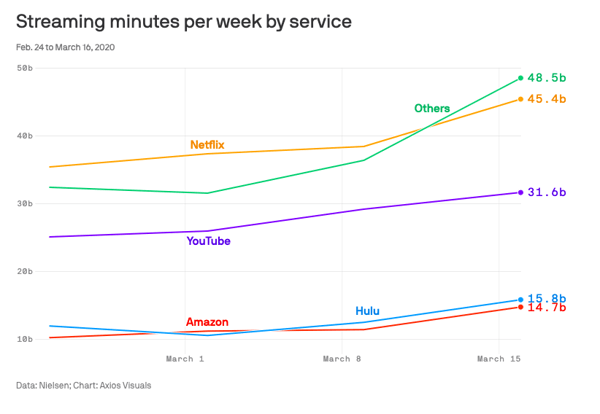Over the past two to three weeks, how many hours have you logged in front of the television?
Even if you weren’t actively watching a movie or TV show, maybe you kept Friends or The Office playing in the background while you worked. We won’t judge you. In fact, some sources have recommended turning the TV on while you work to replicate the ambient noise you would experience working in an office or coffee shop. And to help you feel just a little less lonely.
 Source: Streaming Spikes During Coronavirus
Source: Streaming Spikes During Coronavirus
Independent of its therapeutic properties, TV is taking up a lot of space in our lives these days and demonstrating its power as a conduit for both entertainment and advertisement. Yet, when we talk about “watching TV” we’re referring to the viewing of content across a number of different devices, platforms, and apps – a huge departure from what “watching TV” was 20 years ago. Watching TV on a television is just one part of the video viewing landscape facilitated by the internet’s robust video streaming capabilities.
Like most marketing and advertising terminology, video is now chock-full of acronyms. The acronym du jour for digital marketers is OTT, which stands for Over the Top. Given the current limitations in our mobility and activity, contributing to the approximate 60% increase in content viewing, understanding OTT is more important than ever.
So what is OTT actually? And other definitions.
OTT vs. Linear TV
When we talk about OTT, or Over the Top, we are referring to video content that is delivered through an internet connection but not through a cable or satellite subscription. Linear TV can be thought of traditional television content that comes through a cable or satellite subscription. Linear TV is good ‘ol fashioned TV. OTT is internet TV. Simple enough, right?
CTV
Here’s where things can get a little confusing: devices. Both OTT and Linear TV can be viewed on smart TVs, otherwise known as Connected TVs (CTVs), that have internet connectivity. Think about how on certain TVs you can both stream Netflix and switch to cable to get local news. According to media company Xandr, 89% of OTT viewing takes place on CTVs, so for the purpose of this post, we will use CTV only in reference to the viewing of OTT content.
The OTT Ecosystem
Advertising on OTT is an appealing option for marketers because of the range of devices and platforms it spans. OTT content can be served across three types of devices: Connected Televisions (CTVs), computers (desktop or mobile), and mobile devices (smartphones and tablets).
For Desktop and Mobile devices, you simply visit the website or download the app that will provide you with the content you want, like visiting YouTube on your laptop or the Hulu app on your iPhone. For CTV there are a few intermediate steps. You will usually use an addition player (Roku, AppleTV, Amazon FireTV) to access the apps or publishers (CNN, Bravo, Cartoon Network, etc) to view your desired programming. Below we have an example of the OTT landscape with a small sample of players and publishers.

What does an OTT ad look like?
An ad served on OTT, known as Instream ad, is quite simply a video ad. It can be shown at 3 different points of the viewing process. Pre-roll runs before video content, Mid-roll can be shown at different points throughout the video (like commercial breaks), and Post-roll plays after the video is complete. In our experience, Pre-roll is the most popular placement for Instream ads. Instream ads should not be confused with Outstream ads, which are completely self-contained and stand-alone videos on a webpage, are not part of the OTT ecosystem.
Why should marketers care?
As mentioned earlier, the reach of OTT is wide and expanding rapidly due to the unprecedented increase in CTV viewership. OTT has the benefits of traditional display advertising with the added guarantee of a much higher viewability and completion rates. OTT gives marketers control over how and when ads are served and ensures brand safety. And, with one ad buy, you reach can premium audiences across the three devices in the OTT ecosystem (CTV, Desktop, and Mobile).
While the idea of advertising on TV might seem beyond your reach, OTT is here to prove otherwise. If you have access to high quality video assets that you’ve used for other display campaigns, you’re already three quarters of the way there. With the right digital partner, OTT can be integrated into your existing digital campaigns and you can begin to reap the benefit of fully maximizing your ad spend before the rest of the world catches on.
To learn more about advertising on OTT with Cybba, watch our webinar OTT: Launching Your Brand Over the Top, or reach out to our digital media specialists.


